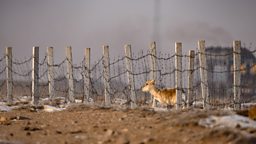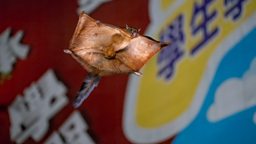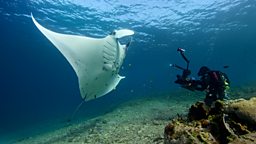Filming Taipei's giant flying squirrels
By Henry Lin, Researcher and Field Director
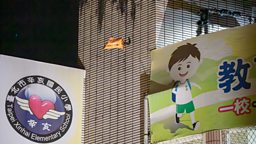
Taipei, one of Asia's most densely-populated cities, is a sprawling urban landscape that supports a surprisingly diverse array of wildlife. Amidst the bustling streets and towering skyscrapers, various animals have carved out niches to coexist with the human population, making their homes within the city’s buildings.
...I’ve long been captivated by the diverse wildlife thriving in urban environments.
As somebody raised in Taipei, I’ve long been captivated by the diverse wildlife thriving in urban environments. Growing up surrounded by these creatures sparked my interest in the natural world, ultimately leading me to pursue a career in wildlife filmmaking. From insects and birds to snakes and amphibians, I’ve witnessed how, in many parts of Asia, people demonstrate an incredible ability to coexist with wildlife, enabling various species to flourish alongside the human population.
For the Crowded Continent episode of the Asia series, we set out to capture compelling stories of this coexistence, focusing on mammals that are both relatable and less familiar than common urban species like rats or mice. Our search spanned three years, during which we reached out to scientists, photographers, and locals across Asia. However, most of the stories we encountered involved animals merely passing through cities rather than making a home within urban buildings.

Everything changed when I stumbled upon a clip from a local Taiwanese documentary directed by Marina Pai. It featured Formosan giant flying squirrels – nocturnal, cat-sized mammals with bushy tails and a wing-like membrane called a patagium, which they use to glide. These squirrels were living in the ceilings of a residential building near a patch of jungle. Growing up, I had spotted flying squirrels during night hikes in the hills around Taipei, but those sightings were always brief. Capturing them on camera had seemed impossible, and I had never considered that these squirrels might inhabit urban buildings.
...nocturnal, cat-sized mammals with bushy tails and a wing-like membrane...
Motivated by this discovery, I began my research. After scouring social media for hours, I found a Facebook post from a local elementary school in Taipei featuring a photo of a flying squirrel asleep on a window ledge. I immediately contacted the school and arranged a meeting. I took along my partner Marie Bell, who is a wildlife photographer, and we met with the school’s directors, who took us to the library on the top floor. Behind an opaque window, we watched in amazement as a Formosan giant flying squirrel reorganised its nest bedding. We had finally found a subject for our sequence.
That evening, Marie and I returned to the school after the squirrel had left for the night and installed several remote cameras in the library to monitor its movements. Soon, this squirrel – and others we discovered in the school – became an obsession. Every morning, we eagerly checked the footage to ensure they had returned to their nests. After months of observation, we identified one male squirrel that consistently appeared in the library, regardless of the weather or season. This particular squirrel would eventually become the star of our sequence.

However, we faced a significant challenge: these urban squirrels weren’t being tracked or studied by scientists. We knew very little about their behaviour, habits, or movement patterns. Marie and I spent countless nights staking out the school grounds with thermal scopes, but even with this technology, following their movements proved difficult. Their glides were fast and unpredictable, often disappearing behind buildings within seconds. Over time, we learned to recognise their distinctive calls and predict their behaviour, eventually understanding when they were likely to leap and which routes they preferred to reach the jungle.
The crew often attracted curious locals...
After months of preparation, the rest of the crew arrived in Taipei to begin filming. The team had travelled from the UK with over thirty cases of specialist equipment. It consisted of myself as the sequence director, Luke Barnett, a wildlife cinematographer experienced in filming flying squirrels; long-lens camera operators Alex Tivenan and Abi Thomas; remote camera specialist Michael Geier; rope and rigging expert Alistair Rickman; and Marie.
Filming urban wildlife presents unique challenges. The crew often attracted curious locals who would stop to ask what we were filming, and one evening, the police arrived after some bystanders mistook us for paparazzi. I explained our mission and shared footage of the flying squirrels, to the surprise of locals who had no idea these animals lived in the city.
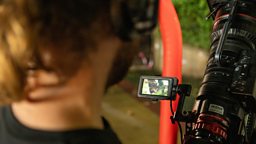
Filming at night posed its own difficulties. Most nights, the crew stayed awake until 4:00 or 5:00 am, waiting for signs of the squirrels. Their unpredictable movements meant long stretches of inactivity, followed by sudden bursts of action if someone spotted a squirrel preparing to glide. Capturing these fleeting moments was a constant struggle, as the squirrels would often glide out of sight into the dense jungle within seconds. There were frustrating nights when hours of setup yielded no footage because the squirrels chose unexpected routes.
Most nights, the crew stayed awake until 4:00 or 5:00 am
Additionally, we had to contend with Taipei’s unpredictable spring rains, which could drench our equipment just as we were getting ready to film. Each day felt like a gamble, not just with the weather, but also in trying to predict the squirrels’ flight paths. While we had identified certain trees in the school grounds that the squirrels frequently used as take-off points, they often ignored those spots completely during filming. On one memorable night, we thought we had lost sight of a squirrel behind the buildings, only for it to leap off the school’s six-storey rooftop and glide over eighty metres into the nearby trees. This unpredictability kept us constantly adjusting our setup, which was both nerve-wracking and exhilarating. As the shoot progressed, the team became better at anticipating the squirrels’ movements and capturing extraordinary footage.
One fascinating discovery from our remote cameras was that the squirrels seemed to time their flights with traffic lights, waiting for cars to stop before gliding across busy roads to the jungle beyond.

As a Taiwanese wildlife filmmaker, capturing intimate footage of these urban flying squirrels has been incredibly rewarding. Through the Asia series, I have the opportunity to not only entertain, educate, and inform Taiwanese audiences about the remarkable animals living in their midst, but also to showcase the Formosan giant flying squirrel to a global audience.
...without the natural patches of jungle scattered throughout Taipei’s urban landscape, these squirrels wouldn’t be able to thrive.
Throughout this project, I often wondered why these squirrels chose to inhabit the city. Perhaps they face less competition for tree cavities from other animals like owls or other squirrels compared to the jungle. Fortunately, Taiwanese scientists are working to uncover these mysteries.
One thing is certain: without the natural patches of jungle scattered throughout Taipei’s urban landscape, these squirrels wouldn’t be able to thrive. Their diet relies on a variety of fruits, seeds, and leaves that only a healthy jungle ecosystem can provide. This serves as a reminder that no matter how small, natural habitats are essential for the survival of urban wildlife. Capturing the stories of Taipei's urban wildlife has reaffirmed my belief in the importance of preserving our natural spaces, even amidst the concrete jungle. As I progress in my career as a wildlife filmmaker, I hope to have the opportunity to film these remarkable squirrels again, showcasing their unique adaptations and the vital role they play in our urban ecosystems.

The flying squirrel of Taipei
A squirrel glides over the dangers of urban Taipei to find food in the heart of the city.


